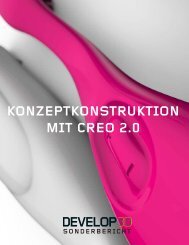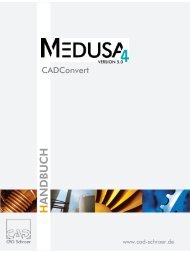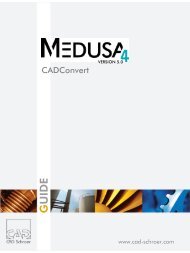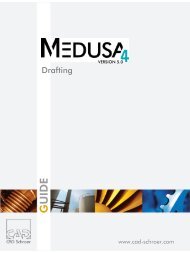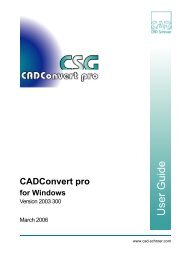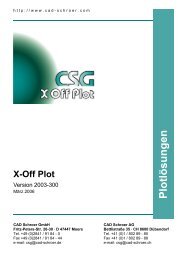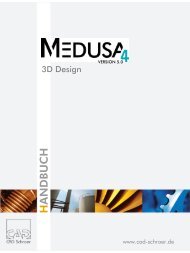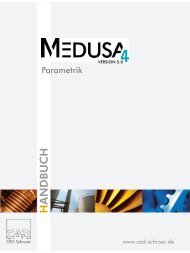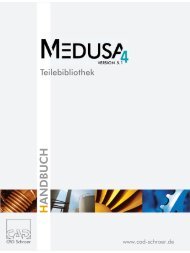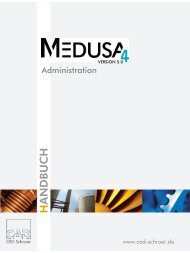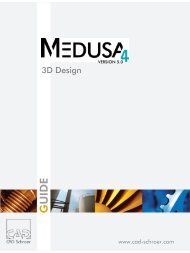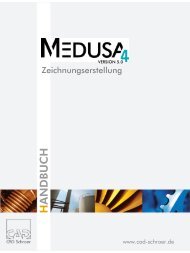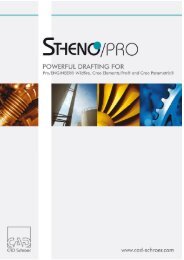Design: Sulzer Pumps - CAD Schroer
Design: Sulzer Pumps - CAD Schroer
Design: Sulzer Pumps - CAD Schroer
You also want an ePaper? Increase the reach of your titles
YUMPU automatically turns print PDFs into web optimized ePapers that Google loves.
A Case in Point: <strong>Sulzer</strong> <strong>Pumps</strong> Germany<br />
The German location, in Bruchsal, near Karlsruhe,<br />
one of <strong>Sulzer</strong> <strong>Pumps</strong>’ top manufacturing facilities,<br />
designs and builds custom pumps for global projects,<br />
and employs 300 people, with around 200 white<br />
collar and 100 highly trained factory staff. At the<br />
Bruchsal site, there are around 35-40 people<br />
involved with <strong>CAD</strong>, amongst them 35 MEDUSA users,<br />
who share 27 concurrent licenses.<br />
Bernd Günter Pfeiffer is the company’s IT Manager,<br />
supported by Winfried Reichert, Technical Data<br />
Processing and Network Manager, who, together with<br />
one of their chief product development engineers,<br />
Georg Hasenfus, managed the MEDUSA4 migration<br />
project in Germany, in close cooperation with<br />
Ms Tischler at HQ in Switzerland. Mr Hasenfus was<br />
one of the first people to receive MEDUSA user<br />
training when the software was introduced about 20<br />
years ago, and it was his job back then to train other<br />
users. Together, the gentlemen explain what the<br />
German company does, and how MEDUSA is critical<br />
to their work.<br />
<strong>Pumps</strong> by <strong>Design</strong><br />
“We focus on pre-engineered pumps, created from a<br />
catalogue of variants, which are customised to suit<br />
individual requirements, mostly for hydrocarbon<br />
processing and power generation applications,”<br />
explains Mr Pfeiffer. Unlike some other German firms,<br />
<strong>Sulzer</strong> <strong>Pumps</strong>’ business is booming and staff numbers<br />
growing: “80% of our products head for export<br />
markets.”<br />
Its product list is impressive and expanding, as the<br />
company fosters organic growth, as well as<br />
acquiring key players in niche markets, such as the<br />
2006 purchase of Crown <strong>Pumps</strong>, Texas, which<br />
specialises in submersible vertical turbine pumps.<br />
<strong>Sulzer</strong> now offers over 46 different series of pumps,<br />
ranging from single stage to barrel, to ring section,<br />
to axial split and vertical pumps.<br />
Its business is based on orders received from<br />
intermediary installation design firms, which<br />
typically provide the complete package (e.g.<br />
complete fire fighting installations for oil rigs) to<br />
the end customer.<br />
Net sales in Germany have been very strong, with<br />
2006 proving to be a bumper year. <strong>Pumps</strong> only make<br />
up 50% of sales; the other half comes from<br />
maintenance and consultancy services. In 2005 the<br />
German firm manufactured 721 pumps; many of<br />
which run into the tens and hundreds of thousands of<br />
Euros in cost. <strong>Sulzer</strong> <strong>Pumps</strong>’ overall sales were up<br />
over 26.4% in 2005 compared with 2004, with a<br />
55.4% increase in operating income.<br />
Projects of all Sizes<br />
“Ours is not a mass market product,” explains<br />
Mr Reichert, “We very much work on a<br />
project basis. Our customers define the extent of<br />
the order – which is usually an aggregate including<br />
the pump, the motor (these we buy in based on<br />
customer specifications), seals, couplings, coolers<br />
etc. Sometimes all we get from them is a drawing<br />
title block with a logo. Sometimes we get an<br />
installation framework. In terms of P&IDs, there are<br />
often prescribed numbering systems, and the seal<br />
or motor suppliers provide us with some basic data,<br />
which we process with our MEDUSA drawings. End<br />
customers want their documentation in various<br />
<strong>CAD</strong> formats. This was one of the reasons for<br />
upgrading to MEDUSA4 – its excellent data<br />
exchange capabilities with Auto<strong>CAD</strong> and other<br />
systems.”<br />
Mr Hasenfus adds, “There is really never a case<br />
when a standard pump doesn’t have to be<br />
customised in some way or another, even if it’s just<br />
an installation diagram, or a new motor added to<br />
the aggregate.”<br />
Projects can take from 5-6 months for small pumps,<br />
to several years for large projects.



